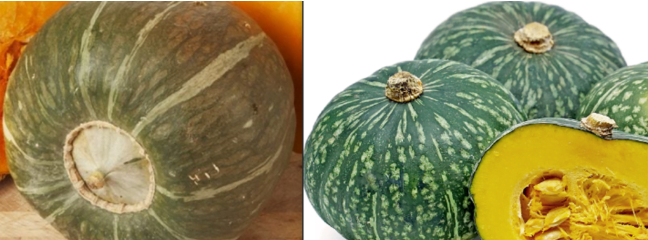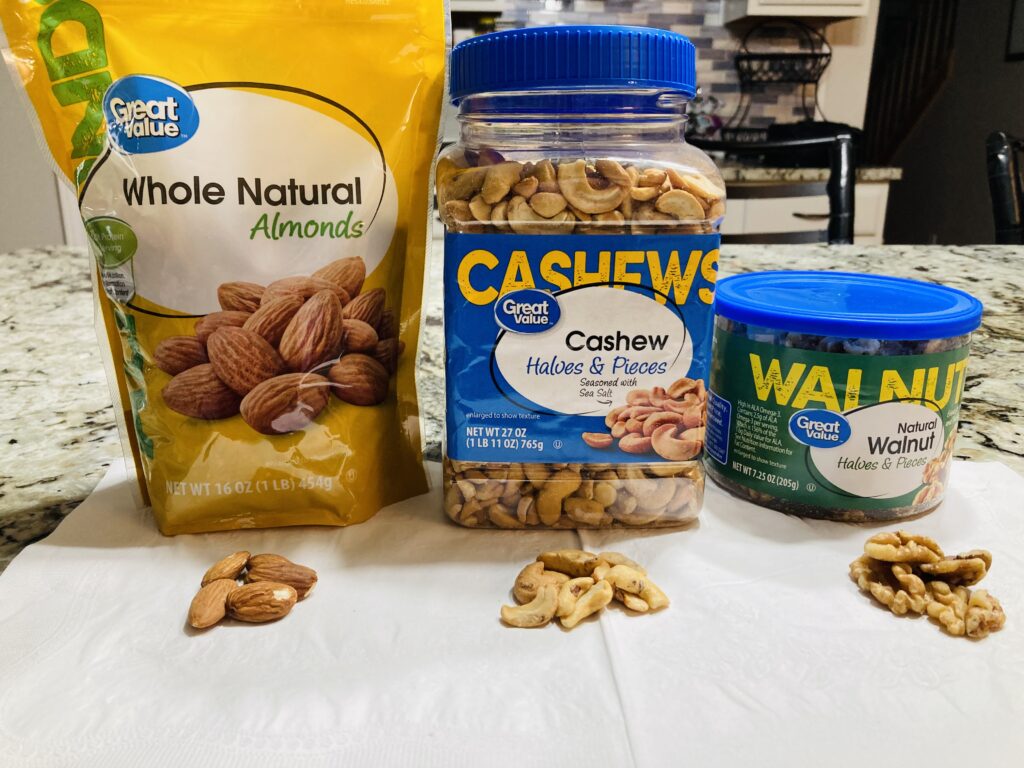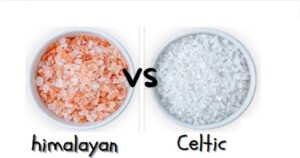Both buttercup squash and kabocha squash are winter squash varieties with sweet, dense flesh, but they have some differences. Buttercup squash has a round shape with a turban-like cap, while kabocha is typically squat and flattened. Buttercup squash has a slightly sweeter taste and smoother texture, while kabocha has a sweet and nutty flavor with a firmer texture. Both are rich in nutrients, including beta-carotene, and can be used interchangeably in many recipes, though the specific flavor and texture differences may affect the outcome.
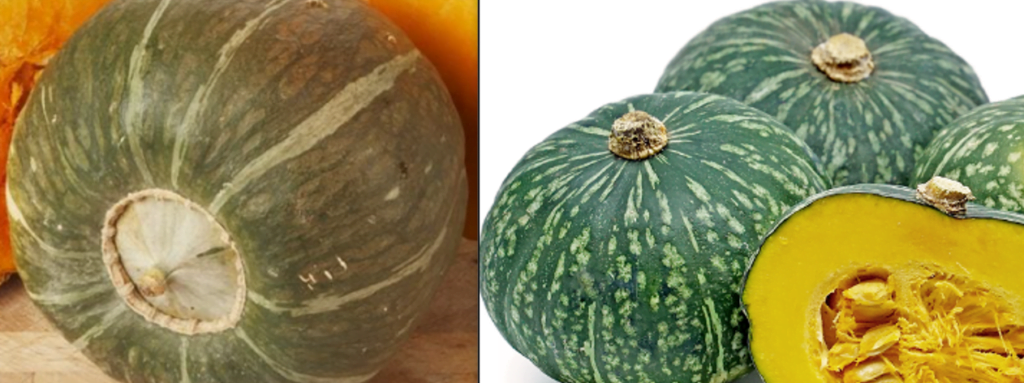
Physical Characteristics of Buttercup Squash and Kabocha
| Buttercup Squash | Kabocha |
|---|---|
| Turban or bell-shaped, medium to large | Squat and round, smaller than Buttercup |
| Dark green with a lighter, creamy spot | Variable; can be green, orange, or red |
| Smooth, tough, and ridged | Smooth and slightly bumpy |
| Orange-yellow | Bright orange |
| Sweet and nutty | Sweet and slightly nutty |
| Dense and dry | Smooth and tender |
| Rich in vitamins A and C, potassium, fiber | High in beta-carotene, iron, and vitamin C |
| Baking, roasting, mashing | Roasting, steaming, soups, stews |
| Buttercup Squash Soup, roasted squash | Kabocha Curry, tempura, steamed slices |
| Turban or bell-shaped with a distinct cap | Round and squat with a smoother surface |
| Baking and roasting | Roasting and steaming |
| Widely available, especially in the fall | Common in Asian markets, available year-round |
| Stores well in a cool, dark place | Stores well in a cool, dry place |
These characteristics provide a general overview, but individual preferences and culinary applications may vary.
Buttercup Squash brief History and Origin
Buttercup squash is a winter squash variety that belongs to the Cucurbitaceae family, which also includes pumpkins and zucchinis. Cucurbita maxima, part of a group of five cultivated squash species, stands out as one of the most genetically diverse domesticated species. Its roots trace back to South America, where it evolved from the wild subspecies Cucurbita maxima subsp.

Taste and Flavor of the Buttercup Squash
The flesh of the buttercup squash is sweet and creamy, with a rich and nutty undertone. Its texture is smooth and dense, making it a popular choice for various culinary applications.
When cooked, buttercup squash develops a tender and velvety consistency, and its flavor intensifies. Roasting or baking the squash enhances its natural sweetness, and it can be enjoyed on its own or used in a variety of dishes. Common preparations include steaming, sautéing, or mashing the squash, incorporating it into soups, stews, casseroles, and even desserts.
The flavor profile of buttercup squash pairs well with complementary ingredients such as brown sugar, cinnamon, and nutmeg. Its versatility makes it suitable for both savory and sweet dishes, adding a comforting and earthy element to meals. Overall, the taste of buttercup squash is a delightful combination of sweetness and nuttiness, making it a favorite among those who appreciate the rich flavors of winter squash varieties.
Flavor and Taste of Buttercup squash vs Kabocha
Buttercup Squash:
- Taste: Buttercup squash has a sweet and nutty flavor.
- Texture: The texture is creamy and dense, making it suitable for various cooking methods.
- Flavor: The flavor is rich and slightly sweet, with a nutty undertone.
Kabocha Squash:
- Taste: Kabocha squash has a sweet and earthy flavor.
- Texture: The texture is smooth and tender, similar to a sweet potato.
- Flavor: Kabocha squash has a sweet, rich flavor with a hint of chestnut.
While both varieties share a sweet taste, the specific nuances of their flavors and textures can be distinct. Buttercup squash tends to be a bit denser and nuttier, while Kabocha is often described as having a chestnut-like flavor with a smoother texture. Individual preferences can vary, and these descriptions are generalizations. Cooking methods and recipes can also influence the overall taste and flavor of these squashes.
Nutritional Value of Buttercup Squash
buttercup is rich in vitamins A and C as well as magnesium. It’s rich in potassium, offering 26% of the recommended daily value. Potassium is important for fluid balance and blood pressure, and most Americans don’t get enough (eat more of these potassium-rich foods). It also offers a variety of carotenoid antioxidants.
Nutrition Facts
| Nutrient | Amount per Serving |
|---|---|
| Serving Size | 0.75 cup (85g) |
| Calories | 30 |
| Calories from Fat | 0 (0%) |
| Total Fat | 0g |
| Sodium | 0mg (0%) |
| Carbohydrates | 7g |
| Net carbs | 6g |
| Fiber | 1g (4%) |
| Glucose | 3g |
| Protein | 1g |
Vitamins and minerals
| Nutrient | Amount per Serving |
|---|---|
| Vitamin A | 630μg (70%) |
| Vitamin C | 13.5mg (23%) |
| Calcium | 20mg (2%) |
| Iron | 0.2mg (3%) |
Health benefits of Buttercup Squash
Buttercup squash, similar to kabocha squash, is a low-calorie winter variety with just 34 calories per 3.5 Oz (100 g). It serves as an excellent source of both soluble and insoluble dietary fiber and contains no saturated fats or cholesterol. Being gluten-free, Buttercup squash is a suitable alternative for individuals with gluten sensitivity, such as those with celiac disease.
Rich in carotenoids and vitamin A, it provides approximately 1370 IU per 3.5 Oz (100 g) and 820 μg of β-carotene. Vitamin A acts as a crucial antioxidant, promoting cell growth, aiding in mucosal repair, combating cancer, and supporting good vision.
Alongside vitamin A, the polyphenolic pigment compounds found in Buttercup squash actively combat detrimental oxygen-derived free radicals and reactive oxygen species (ROS) within the body, contributing to the prevention of cancers, aging, and various inflammatory diseases.
Fresh Buttercup squash boasts higher quantities of vitamin C (20% of the Recommended Daily Allowance (RDA) per 3.5 oz), pyridoxine, and thiamin compared to pumpkin. Vitamin C is crucial for collagen synthesis in bones, cartilage, and blood vessels, and it facilitates iron absorption.
Furthermore, Buttercup squash serves as a notable source of folates, providing 24 µg or 6% of the RDA per 3.5 oz. Folate acts as a cofactor in cell division and DNA synthesis, playing a pivotal role in preventing neural tube defects in newborns when consumed during the early stages of pregnancy by expectant mothers.
Buttercup, a type of winter squash, is characterized by its low sodium content at 3 mg per 100 grams. Conversely, it boasts a generous supply of potassium, a crucial intracellular electrolyte. Potassium plays a heart-healthy role by mitigating the adverse impacts of sodium, leading to a reduction in blood pressure and heart rate.
Additionally, Buttercup squash is rich in various B-complex vitamins, including pyridoxine, thiamin, pantothenic acid, and riboflavin. It also provides essential minerals such as copper, selenium, calcium, iron, manganese, phosphorus, and zinc.
| Nutrient | Buttercup Squash (per 3.5 Oz / 100g) |
|---|---|
| Calories | 34 |
| Dietary Fiber | Excellent source |
| Saturated Fats | None |
| Cholesterol | None |
| Gluten-Free | Yes (suitable for celiac disease) |
| Vitamin A | 1370 IU, 820 μg β-carotene |
| Vitamin C | 20% of RDA |
| Vitamin B6 (Pyridoxine) | Higher than pumpkin |
| Thiamin | Higher than pumpkin |
| Folate | 24 µg, 6% of RDA |
| Potassium | 350 mg |
| Sodium | 3 mg |
| Other Nutrients | B-complex vitamins, copper, selenium, calcium, iron, manganese, phosphorus, zinc |
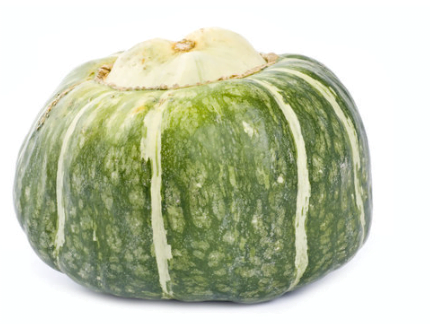
Factors to consider When selecting a buttercup squash
- Firmness: As you mentioned, the cap of the squash, which is the rounded top where the stem was attached, should feel firm when gently pressed. If it gives slightly under pressure but doesn’t feel overly soft or mushy, it’s likely ripe. Avoid squashes with soft spots or indentations.
- Color: A ripe buttercup squash typically has a deep, rich color. The skin should be a uniform dark green with a matte finish. Avoid squash with dull or mottled skin, as this could indicate it’s not as fresh.
- Weight: A good-quality buttercup squash should feel heavy for its size. Heft it in your hand; a heavier squash generally indicates a higher moisture content, which is desirable for better flavor and texture.
- Stem: The stem should be dry and firm. A green, pliable stem is an indication that the squash was recently harvested. If the stem is dry and woody, it might have been sitting for an extended period, affecting its freshness.
- Dullness: The skin of a ripe buttercup squash should have a dull, matte finish rather than a shiny one. Shiny skin can be a sign that the squash was picked too early.
- Avoid Bruises or Cuts: Inspect the squash for any visible bruises, cuts, or blemishes. A healthy squash should have smooth, unbroken skin.
- Store Environment: If possible, consider where the squash is displayed in the store. Squashes stored in cool, dry conditions are more likely to stay fresh longer.
Keep in mind that the flavor and texture of buttercup squash can improve if you allow it to ripen a bit more after purchase. Store it in a cool, dry place for a week or two before using. If you plan to store it for a more extended period, keep it in a well-ventilated area with moderate temperatures.
Culinary uses of Buttercup Squash
Buttercup squash, with its sweet and creamy flesh, is a versatile ingredient in the kitchen. Here are some culinary uses for buttercup squash:
- Roasting: Cut the squash into wedges or cubes, toss them with olive oil, salt, and pepper, and roast until they’re caramelized and tender. Roasted buttercup squash can be served as a side dish or added to salads.
- Mashing: Boil or steam buttercup squash until it’s soft, then mash it with butter, salt, and pepper. This makes a delicious and nutritious alternative to mashed potatoes.
- Soup: Buttercup squash makes a rich and velvety soup. Combine it with onions, garlic, broth, and your favorite seasonings. Blend the mixture until smooth for a comforting soup.
- Stir-Frying: Cut buttercup squash into small pieces and stir-fry with other vegetables, tofu, or meat. The sweet flavor of the squash adds depth to stir-fry dishes.
- Stuffed Squash: Halve the squash, remove the seeds, and roast until almost tender. Fill the cavities with a mixture of grains, vegetables, and protein, then bake until everything is cooked through.
- Curries: Incorporate buttercup squash into curry dishes for a sweet and creamy element. It pairs well with coconut milk, spices, and proteins like chicken or tofu.
- Risotto: Add diced buttercup squash to your favorite risotto recipe. The squash will impart a rich, sweet flavor to the dish.
- Baked Goods: Use cooked and mashed buttercup squash in baking recipes. It can be added to muffins, pancakes, or quick breads for moisture and sweetness.
- Pasta Sauce: Puree cooked buttercup squash and mix it with cream or broth to create a flavorful pasta sauce. Add herbs, garlic, and Parmesan cheese for extra depth of flavor.
- Grilling: Cut buttercup squash into thick slices or wedges and grill until they develop grill marks. This method enhances the natural sweetness of the squash and adds a smoky flavor.
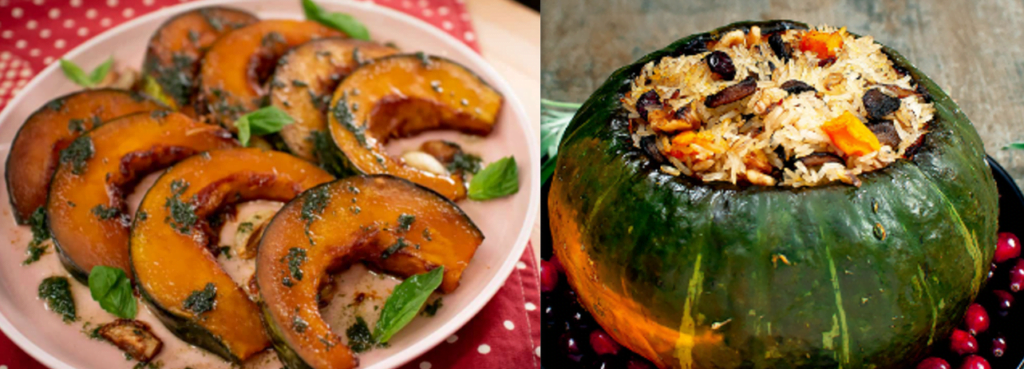
Kabocha Brief History and Origin
Introduced to Japan in 1541 through Portuguese sailors who brought it from Cambodia. The Portuguese referred to it as Camboja abóbora, but the Japanese later adopted the name kabocha. Another possible Portuguese origin is the word cabaça for gourd. It is also called Japanese pumpkin. kabocha squash was initially embraced as a novel vegetable. The name kabocha reflects its Cambodian origins.
The traditional Japanese kabocha, Nihon kabocha, is characterized by its rough skin and juicy interior. However, the Western kabocha, or winter squash, imported from the United States in the nineteenth century, has become the prevailing choice in today’s market. In China, the term is used for various squashes with tougher skin and denser flesh, including pumpkins, extending beyond the specific type of kabocha.
Nutritional Value of Kabocha
- Calories: Approximately 40 calories
- Carbohydrates: About 9 grams
- Dietary Fiber: Around 1.5 grams
- Sugars: About 2.6 grams
- Protein: Approximately 1 gram
- Fat: About 0.1 grams
- Vitamin A: Very high, providing more than the daily recommended intake
- Vitamin C: Moderate, providing about 12% of the daily recommended intake
- Vitamin E: Low, providing about 6% of the daily recommended intake
- Vitamin B6: Moderate, providing about 10% of the daily recommended intake
- Folate (B9): Moderate, providing about 9% of the daily recommended intake
- Potassium: High, providing about 12% of the daily recommended intake
- Magnesium: Moderate, providing about 8% of the daily recommended intake
- Iron: Low, providing about 4% of the daily recommended intake
Health Benefits of Kabocha
Kabocha squash stands out as a nutritious powerhouse, boasting significant levels of vitamin A, fiber, and flavonoids such as beta-carotene. Its health benefits are further enhanced by the fact that it contains zero sodium, fats, and cholesterol. This makes kabocha squash a wholesome addition to your diet, promoting overall well-being and contributing to a heart-healthy and low-cholesterol lifestyle.
Kabocha squash, with its nutrient profile, offers several health benefits:
- Low in Calories: With only 29.8 calories per 85-gram serving, kabocha squash is a low-calorie food, making it suitable for those looking to manage their calorie intake.
- Rich in Fiber: The 1.02 grams of fiber per serving can contribute to digestive health by promoting regular bowel movements and supporting a healthy gut.
- Source of Vitamin A: Kabocha squash is high in vitamin A, providing 3850 international units per serving. Vitamin A is essential for maintaining healthy skin, vision, and immune function.
- Vitamin C Content: With 9.01 milligrams of vitamin C, kabocha squash contributes to the body’s antioxidant defenses, supports collagen formation, and helps boost the immune system.
- Calcium: Kabocha squash contains 20.4 milligrams of calcium per serving, contributing to bone health, muscle function, and nerve transmission.
- Potassium: With 350 milligrams of potassium, kabocha squash supports heart health by helping regulate blood pressure and fluid balance.
- Low in Sugars: With only 3 grams of sugars, kabocha squash is a healthier option compared to high-sugar foods, which can contribute to better blood sugar control.
Incorporating kabocha squash into a balanced diet can be a nutritious way to enjoy a variety of essential vitamins and minerals while keeping calorie intake in check.
1. Improves blood sugar levels.
Good for controlling blood sugar levels because it’s lower in calories and carbs than sweet potatoes. It has a low glycemic index, meaning it slowly raises and steadies blood sugar. The fiber in kabocha keeps you full for longer, preventing quick spikes in blood sugar. Additionally, the seeds of kabocha squash have healthy fats and protein that contribute to stable blood sugar levels.
2.Decreases blood pressure
Abundant in potassium and fiber, aids in regulating sodium levels and reducing blood pressure.
3.Protects heart health
Kabocha contains no fats or cholesterol, contributing to the maintenance of cholesterol levels. Studies indicate that Cucurbita maxima exhibits antioxidant effects, reducing cholesterol buildup, supporting heart health, and preventing cardiovascular issues.
4. Protects from oxidative damage.
Kabocha is packed with vitamins A and C, along with flavonoids and polysaccharides. These nutrients act as antioxidants, shielding our cells from damage caused by free radicals. By preventing oxidative damage, kabocha helps maintain healthy cells, slows down aging, and guards against long-term health issues.
5.Promote healthy skin
Studies reveal that kabocha squash has flavonoids, such as beta-carotene and lutein, that are good for your skin. These compounds help prevent skin cell damage, inflammation, and oxidation. By using kabocha squash, you might shield your skin from harm, slow down aging, and reduce the risk of cancer growth. So, including kabocha squash in your diet could be beneficial for your skin health
6. Improves eye health.
Rich in essential nutrients such as vitamins A and C, beta-carotene, lutein, and zeaxanthin, all of which play a crucial role in maintaining eye health. These components work together to prevent oxidative damage and inflammation, providing protection against age-related disorders like macular degeneration and contributing to overall eye well-being.
7.Fight against cancer growth
Kabocha is a source of flavonoids such as beta-carotene and lutein, known for their antioxidant properties. These compounds play a crucial role in shielding your cells and DNA from free radical damage, thereby aiding in the prevention of cancer cell growth.Research indicates that the presence of lutein and zeaxanthin in kabocha squash may offer protection against skin cancer. Additionally, the vitamin C found in this plant enhances the immune system, neutralizes free radicals, and hinders the growth of cancer cells.
How to choose the right kabocha when Buying
When selecting a kabocha squash, opt for one with a firm, hard, and deeply colored rind, which toughens as it ripens. Ensure there are no soft spots, cracks, or mold on the skin. A desirable kabocha pumpkin should have a matte, hard exterior, while shiny or soft ones are likely unripe and should be avoided. Steer clear of squash with soft areas or a moldy stem, as these may indicate overripeness.
In the event you purchase an unripe squash, expose it to sunlight to facilitate ripening. For mature or ripe kabocha squash, store it in a cool, dark location, avoiding refrigeration. Consume it within a month for optimal flavor. Once the squash is cut, wrap it in plastic and refrigerate, consuming within five days.
Simple trick to cutting Kabocha in the video below
Can Kabocha be substitute in Butternut and Acorn squash recipes?
Yes, kabocha squash can indeed be used as a substitute in recipes that call for butternut squash or acorn squash. Kabocha squash, also known as Japanese pumpkin, has a sweet and dense flesh with a texture that is somewhat similar to sweet potato or chestnut. It’s a versatile squash that can be roasted, steamed, mashed, or used in soups and stews.
When substituting kabocha squash for butternut squash or acorn squash, keep in mind that the flavors and textures may vary slightly, but the substitution is generally interchangeable. Just be aware that kabocha has a sweeter taste compared to acorn squash and a firmer texture than butternut squash. Adjusting seasoning to taste and keeping an eye on cooking times can help you achieve the desired result in your recipe.
10 different ways to cook Kabocha
- Roasting and Grilling:
- Cut kabocha into wedges or cubes, toss with olive oil, salt, and your favorite herbs or spices.
- Roast in the oven or grill until the edges caramelize, bringing out its natural sweetness.
- Soups and Stews:
- Kabocha adds a rich and velvety texture to soups and stews.
- Cube the kabocha and add it to your favorite soup or stew recipes.
- Curries:
- Kabocha is a great addition to curries, bringing a slightly sweet and nutty flavor.
- Cut it into chunks and simmer in your favorite curry sauce.
- Mashed Kabocha:
- Boil or steam kabocha until tender, then mash it just like you would with potatoes.
- Add butter, salt, and pepper for a delicious mashed kabocha side dish.
- Fried Kabocha:
- Coat sliced kabocha in a light batter and deep-fry until golden brown.
- Sprinkle with salt or your favorite seasoning for a tasty snack or side dish.
- Kabocha Pie or Tart:
- Puree kabocha and use it as a filling for pies or tarts.
- Its natural sweetness complements spices like cinnamon, nutmeg, and ginger.
- Kabocha Gnocchi:
- Mix mashed kabocha with flour and egg to make a dough.
- Form the dough into gnocchi shapes and cook until they float to the surface of boiling water.
- Kabocha Sushi Rolls:
- Use thin strips of raw or lightly steamed kabocha as a filling for sushi rolls.
- Combine it with other ingredients like avocado and cucumber for added flavor and texture.
- Kabocha Pancakes or Waffles:
- Incorporate mashed kabocha into pancake or waffle batter for a unique and nutritious breakfast treat.
- Kabocha Risotto:
- Add diced kabocha to your favorite risotto recipe.
- Its creamy texture and sweet flavor can enhance the overall richness of the dish.
How to store Buttercup squash and kabocha
Storing buttercup squash and kabocha squash is similar to storing other winter squash varieties. Here are some general guidelines to help you store them properly:
- Harvest at the Right Time: Harvest the squash when they are mature but before the first frost. The skin should be hard and difficult to pierce with your fingernail.
- Curing: After harvesting, cure the squash by allowing them to sit in a warm (80-85°F or 27-29°C), dry place for 10 to 14 days. This helps the skin harden and the flavors develop.
- Cleaning: Wipe off any dirt on the surface of the squash. Do not wash them, as moisture can encourage mold growth.
- Storage Location: Store the squash in a cool, dark place with good ventilation. A pantry, cellar, or basement is ideal. The temperature should be between 50-55°F (10-13°C).
- Proper Ventilation: Ensure good air circulation around the squash to prevent mold and rot. Do not stack them on top of each other.
- Check for Spoilage: Regularly inspect the stored squash for signs of spoilage. If you notice any soft spots, mold, or other signs of decay, remove the affected squash immediately.
- Separate Damaged Squash: If one squash starts to rot, it can quickly spread to others. Therefore, it’s important to remove any damaged or decaying squash promptly.
- Use First-In, First-Out (FIFO): Consume the squash in the order they were harvested. Use the ones with shorter storage lives first.
- Consider Refrigeration: While a cool, dark place is ideal, if you don’t have a suitable storage location, you can refrigerate them. However, keep in mind that refrigeration can affect the texture and flavor over time.
By following these guidelines, you can extend the storage life of buttercup squash and kabocha squash, allowing you to enjoy them over an extended period. Always remember that individual squash may vary in terms of storage life, so regular monitoring is crucial.
Resources
https://www.nutrition-and-you.com/buttercup-squash.html
https://www.webmd.com/diet/health-benefits-of-kabocha-squash
https://www.eatthismuch.com/food/nutrition/buttercup-squash,139529/
https://www.kikkoman.com/en/culture/foodforum/spirit-of-the-seasons/
